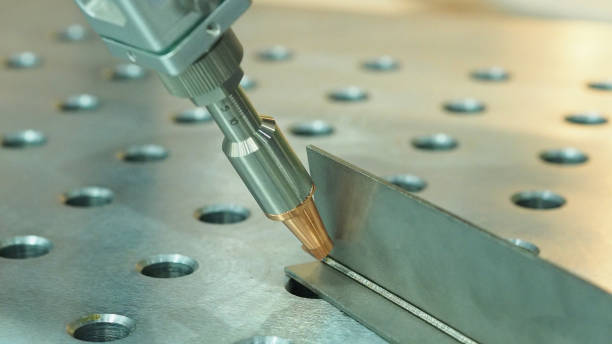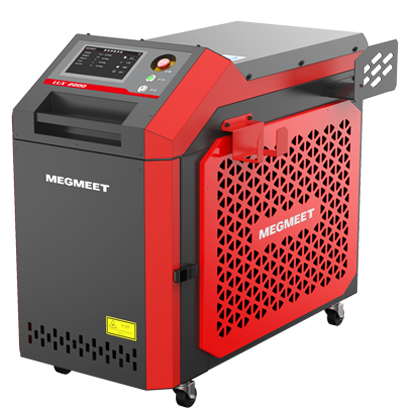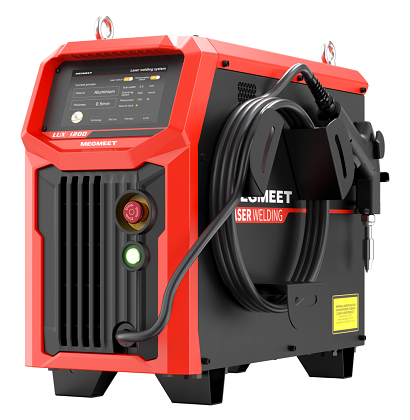In laser welding, thermal management is not optional — it is core to performance. A Water-Cooled Laser Welder or an Air-Cooled Laser Welder serves as the heart of that thermal system, and the choice between them impacts beam stability, duty cycle, system complexity, and cost. The question Water-Cooled Laser Welder vs Air-Cooled Laser Welder is not about superiority per se, but about matching the cooling approach to your application demands. In this article, we’ll compare each cooling method in depth, explore real-world integration trade-offs, present performance highlights, propose best practice guidelines, and help you choose the right cooling architecture for your welding project.

I. Whay Cooling Methods Matter in Laser Welding?
Cooling is not an incidental accessory — it is central to laser performance. Laser sources (diode stacks, fiber amplifiers, solid-state modules, and CO₂ heads) generate heat where electrical energy converts to optical output. Excess temperature or thermal gradients change refractive index, induce thermal lensing, shift alignment, reduce beam quality, and accelerate component aging. The cooling strategy determines how effectively that heat is removed, which in turn affects:
Output power stability over long weld runs.
Beam quality (M²) and focusability for precision welding.
Maximum continuous duty cycle and allowable peak power bursts.
Service intervals, footprint, and integration complexity.
So when you compare Water-Cooled Laser Welders vs Air-Cooled Laser Welders, you’re really comparing different approaches to controlling temperature and thermal stability at the heart of the laser.
II. How the Water-Cooled and Air-Cooled systems work?
1) Water-cooled systems:
A water-cooled system circulates a liquid coolant through channels or jackets adjacent to heat-generating components. The warmed coolant then passes through a heat exchanger or chiller, shedding heat to ambient, before returning.

Strengths of water cooling:
High cooling capacity and thermal headroom
Tighter temperature control and better thermal uniformity
More stable operation under heavy loads
Quieter in many cases (less reliance on high-speed fans)
Less sensitivity to ambient air temperature fluctuations
Challenges & trade-offs:
More complex infrastructure: pumps, plumbing, reservoirs, leak detection
Higher upfront cost and design effort
Maintenance overhead: coolant quality, filtration, possible scaling or microbial growth
Larger footprint and added weight from chillers and plumbing
Many reviews emphasize that water cooling is indispensable for high-power, continuous-weld systems, while air cooling may suffice in lighter or intermittent applications.
2) Air-cooled systems
In an air-cooled design, modules are thermally tied to heatsinks or finned structures. Fans or blowers drive ambient air over these surfaces to carry heat away. The system is self-contained: no pump loops, no external chillers, no plumbing.

Strengths of air cooling:
Simpler setup — fewer components, no fluid plumbing
Lower initial cost (no chiller or water system)
Compact footprint and lighter weight
Reduced maintenance associated with fluids (no leaks, no coolant replacement)
Limitations & challenges:
Lower maximum thermal removal capacity — performance degrades at high power or extended duty
More sensitivity to ambient conditions — on a hot day or constrained ventilation, cooling margin shrinks
Noise from fans and dust intake over time
Potential for temperature drift or gradient under load
Some sources note that air-cooled systems are better suited to lower-power or pulsed lasers, and often struggle when pushed into continuous or high-load modes.
III. Side-by-Side Comparison of Water-Cooled Laser Welders and Air-Cooled Laser Welders
Below is a practical comparison across the key metrics you’ll care about when choosing a cooling architecture for your welding application.
| Metric | Water-Cooled Laser Welder | Air-Cooled Laser Welder |
|---|
| Thermal removal capacity | High — can clear large heat loads via coolant circulation | Moderate — limited by airflow |
| Temperature stability & drift | Tight control (often ±0.1–1 °C) | More drift, especially under load or ambient swings |
| Duty cycle / continuous operation | Can approach or sustain 100% duty in many cases | Often derated—may require duty cycles<80% at nominal power |
| Ambient dependence | Less sensitive; cooling margin holds in warmer air | Strong dependence; performance may degrade in hotter environments |
| Noise / airflow disturbances | Lower (less fan dependence) | Higher fan noise and airflow turbulence |
| Footprint / infrastructure | Additional space for chiller, piping, pump, reservoir | More compact, minimal auxiliary systems |
| Maintenance / reliability | Needs fluid management, leak control, pump reliability | Simpler, but requires fan maintenance, dust cleaning |
| Integration effort | Requires plumbing, interlocks, flow & temp sensors | Simpler mechanical and electrical integration |
| Cost (CapEx / OpEx) | Higher initial, but better margin under heavy use | Lower upfront cost, but possible performance penalties at scale |
IV. Application scenarios — which to choose by use case
Choosing between a Water-Cooled Laser Welder and an Air-Cooled Laser Welder becomes more tractable when viewed through real-world project lenses.
1) Light or Mobile Welding / Field Repairs
Power levels: typically ≤ 1 kW
Operation: intermittent, spot welding, on-site repairs
Constraints: portability, fast setup, minimal infrastructure
Here, Air-Cooled Laser Welders often lead. Their lighter weight, simpler installation, and lower dependency on auxiliary plumbing make them well-suited. The trade-off is that they may not sustain high duty cycles in hot environments.
2) Medium-Load Production Cells (1–3 kW)
Mixed-usage, moderate duty cycles
Need for better stability and consistency
Possible facility support (ventilation or chillers)
In this intermediate domain, your decision pivots on how aggressively the cell runs. If duty cycles are moderate and ambient control is good, a high-performance air-cooled design may suffice. But if long welding runs or tighter thermal control is required, water cooling begins to offer real security.
3) High-Power, Continuous Production (≥ 3 kW or multi-module systems)
Extended welding runs
Max performance, minimal drift
Integration into automation, robots, factory cells
Here, Water-Cooled Laser Welders are nearly mandatory. Their superior thermal headroom, stability, and ability to cope with high load make them the safer engineering choice. Many industrial laser systems adopt water cooling precisely for such demanding workloads.
4) Research, Lab, Prototype Systems
Moderate power, occasional usage
Changing setups, flexibility valued
Need for stable performance without overcomplication
In labs, air cooling is often chosen for its simplicity. But if you anticipate extended experiments, tight temperature control, or high-power excursions, incorporating a water-cooled architecture may pay dividends in performance consistency.
V. Integration Considerations & Best Practices
Adopting either cooling architecture successfully hinges on thoughtful system integration.
1) Best Practices for Water-Cooled Laser Welders
Careful plumbing and leak prevention: Use high-quality, corrosion-resistant tubing and fittings. Route lines to minimize strain, avoid sharp bends, and allow for thermal expansion.
Flow, pressure, and temperature monitoring: Install sensors to detect pump failure, low flow, or abnormal temperatures. Interlock the laser to fault under abnormal cooling conditions.
Coolant quality & filtration: Use deionized or properly treated coolant. Filter and refresh periodically to prevent scaling or microbial contamination.
Redundancy and safety: In mission-critical setups, include redundant pumps or bypass loops. Provide leak-detection sensors and containment trays.
Chiller sizing & margin design: Oversize your chiller relative to the maximum expected thermal load to preserve margin. If possible, integrate with facility cooling water loops.
Thermal design & uniformity: Ensure coolant paths avoid hotspots and balance flow to all modules to avoid uneven cooling or localized drift.
2) Best Practices for Air-Cooled Laser Welders
Airflow path planning: Ensure unobstructed intake and exhaust paths. Avoid recirculating heat into the system or drawing in dust-laden air.
Fan redundancy and quality: Use high-reliability fans, possibly dual fans in critical axes. Monitor fan current or RPM to detect early failures.
Dust management and filter maintenance: Install dust filters and access panels for regular cleaning. Blocked airflow is a primary cause of thermal stress in air-cooled systems.
Ambient control & ventilation: Enclose or condition the ambient air when possible. Avoid installation in hot, enclosure-limited, or poorly ventilated areas.
Thermal coupling and interface optimization: Minimize thermal resistances with proper thermal interface materials, and ensure heat-sink surfaces and module coupling is optimal.
VI. Performance Highlights & Empirical Insights
While full, public datasets can be scarce, a number of observed trends emerge across industry sources:
In comparable power ranges, water-cooled modules often show 5–10 °C lower operating temperature rise over sustained operation compared to air-cooled counterparts.
Air-cooled designs may need derating (e.g. lowering power or inserting cooling breaks) when ambient exceeds ~30–40 °C.
In repeated or continuous weld runs, water-cooled systems often exhibit more consistent beam quality and lower drift over time.
Operational cost analyses show that although water-cooled systems have higher capital outlay, their better thermal efficiency and lower downtime often reduce total cost of ownership, especially in heavy-duty usage.
Some projects note that air-cooled welders are already stretched near their thermal limits at powers above ~2 kW in warm factory environments, reinforcing the push toward liquid systems.
These empirical pointers underscore the design margin advantage that water-cooled systems often hold.
Conclusion
The decision between a Water-Cooled Laser Welder and an Air-Cooled Laser Welder is not about declaring an absolute winner — it’s about selecting the right fit for your project constraints and performance demands.
For low-power, portable, lightweight, or bench-level operations, an air-cooled laser welder may deliver adequate performance with minimal complexity.
For moderate to high power or where stable, long-duration operation is critical, water cooling becomes increasingly compelling.
In high-throughput industrial contexts or integrated robotic systems, the thermal stability and capacity of liquid cooling often justify the additional investment.
Ultimately, matching your duty cycle, ambient environment, beam quality needs, footprint constraints, and maintenance capabilities to the appropriate cooling strategy ensures you get reliable, high-quality welds without overengineering or underperforming.
Related articles:
1. A Complete Guide to Minimize Metal Spatter & Slag in Laser Welding
2. Safety Protocols for Handheld Laser Welding: A Practical Guide
3. Winter Protection Measures for Handheld Fiber Laser Welders
4. Laser Welding Stainless Steel: Unlocking Precision and Efficiency
5. Laser Welding Copper Guide: Techniques, Challenges, Solutions






